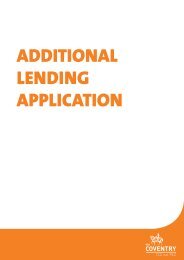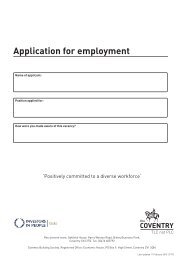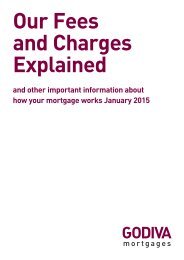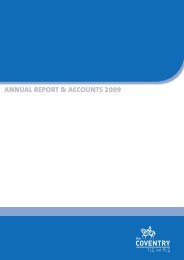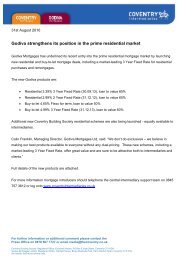ANNUAL REPORT & ACCOUNTS - Coventry Building Society
ANNUAL REPORT & ACCOUNTS - Coventry Building Society
ANNUAL REPORT & ACCOUNTS - Coventry Building Society
Create successful ePaper yourself
Turn your PDF publications into a flip-book with our unique Google optimized e-Paper software.
RISK MANAGEMENT <strong>REPORT</strong>(continued)balances on up to date accounts as at 31 December 2012that had experienced forbearance totalled £148.2 million,0.7% of the mortgage book. A collective provision of£0.2 million is held on the balance sheet for these casesreflecting the very low probability of default, the fact thatover 95% of such assets remain up to date 12 monthsafter the particular event, and also the high value ofcollateral held.In addition, collective provisions have been raised foraccounts not yet past due based on expected arrears andsubsequent loss emergence, with appropriate managementoverlays. Collective provisions have also been raised whereparticular product types may be considered impaired due tomarket factors e.g. geographical location. These collectiveprovisions amounted to £5.7 million (see note 13 to theAccounts).Details of the <strong>Society</strong>’s exposure to retail credit risk arecontained in note 39 to the Accounts.Wholesale credit riskCredit risk within the treasury function (wholesale risk)arises from the portfolio of liquid assets held, and representsthe risk that counterparties will fail to repay amounts whendue. The <strong>Society</strong> has a low appetite for this form of risk. Assuch, exposures are restricted to good quality counterpartieswith a low risk of failure, and limits and exposures are setaccordingly.Treasury exposures and limits are focused in the main onstrong UK institutions, with additional limits extended to asmall number of highly rated banks in Europe and otherdeveloped economies such as Australia and Canada. Limitsare set in line with a Board approved wholesale credit policy,which sets maximum limits taking into account internalanalysis, external credit ratings, country of domicile andany other relevant factors. All credit limits require Boardapproval, and are subject to an initial assessment of thecreditworthiness of the counterparty, with the approved limitthen subject to at least an annual review. Exposures arereviewed on a daily basis to ensure that they remain withinthe approved limits.Ongoing developments for Treasury counterparties areclosely monitored by a specialist credit team, and arereported to, and reviewed by, a dedicated Treasury CreditCommittee. This Committee meets weekly and is chairedby the Chief Risk Officer. The Committee is empowered totake immediate action to reduce or suspend limits wherethis is warranted by adverse changes in the creditworthinessof counterparties or market or local developments. TheCommittee reports through ALCO to the RMC and the BoardRisk Committee.Details of the <strong>Society</strong>’s exposure to wholesale credit risk arecontained in note 40 to the Accounts.Market riskMarket risk is the risk that the value of income derived fromthe <strong>Society</strong>’s assets and liabilities may change adversely asa result of changes in interest rates, foreign exchange ratesor house prices. The <strong>Society</strong>’s policy is to manage these risksprudently, which is ensured through the setting of limits bythe Board. The <strong>Society</strong> ensures compliance with these limitsthrough a combination of matching assets and liabilitieswith off-setting interest rate or currency characteristics,by the use of derivative financial instruments such asinterest rate swaps and caps, foreign exchange swaps andforeign exchange forward purchase contracts, and throughrestrictions on the amount of lending undertaken at higherloan to value. Control of market risk exposure is overseenby ALCO, which reports to the RMC and the Board RiskCommittee. The <strong>Society</strong> has strengthened its second line ofdefence for oversight and independent assessment of thesemarket risks during 2012 through the establishment of aBalance Sheet Risk team reporting to the Chief Risk Officer.The most significant elements of market risk for the <strong>Society</strong>are interest rate risk, foreign currency risk and house pricerisk, each of which are described below.Interest rate riskInterest rate risk arises from the different interest ratecharacteristics of the <strong>Society</strong>’s mortgages and savingsproducts and from other financial instruments. Fixed andcapped rate mortgages and fixed rate savings productsexpose an organisation, that principally operates within avariable rate environment (such as the <strong>Society</strong>) to the riskthat interest rate fluctuations could cause either a reductionin interest income or an increase in interest expense relativeto other interest flows.Where the <strong>Society</strong> has issued fixed rate mortgages, therisk is that a general increase in interest rates would leavethe <strong>Society</strong> facing higher interest expense, but withouta compensating increase in interest income. In thesecircumstances, the <strong>Society</strong> would typically take out aninterest rate swap with a counterparty bank under whichthe <strong>Society</strong>’s fixed rate income is exchanged for one basedon a variable rate which would be expected to follow thegeneral pattern of interest rate movements and therebyreduce the <strong>Society</strong>’s exposure. Similarly, in cases of issuingfixed rate savings products, the <strong>Society</strong> would typically takeout an interest rate swap under which it receives a fixedrate of interest and pays a variable rate. With capped ratemortgages, the risk is that if the rates increase above a predeterminedlevel, the <strong>Society</strong> will be unable to increase itsmortgage rate on these products to compensate. In thesecircumstances, the <strong>Society</strong> would typically purchase a rate30



